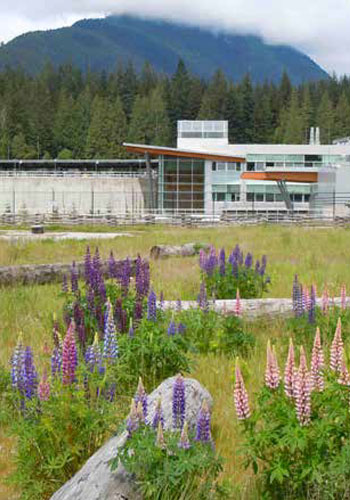Landscape Architecture for a Changing World
What is the purpose of landscape architecture in the 21st century? Is it to beautify public and private spaces with well-chosen plants and pavers? To increase ecological health by mimicking natural systems and processes? Or to manage stormwater and cool our built environment by incorporating green infrastructure? In Landscapes of Change: Innovative Designs and Reinvented Sites, University of Oregon professor Roxi Thoren, Affil. ASLA, argues that 21st century realities demand that landscapes do not just one but all of these things. Works of contemporary landscape architecture must connect neighborhoods, provide wildlife habitat, absorb stormwater, and combat the urban heat island effect.
The book profiles twenty-five landscape projects that meet these hybrid needs in response to the "changing context of landscape architectural design." For example, Jaffa Landfill Park, designed by Braudo-Maoz Landscape Architecture of Tel Aviv, Israel, "used the removal of a landfill and reconstruction of a seashore to ameliorate a painful past and serve as a springboard for social discourse . . . [reestablishing] visual, climatic, and physical connections to the sea that reaffirm the identity of the city."
According to Thoren, some of the changes in landscape architecture are due to shifting perspectives internal to the profession, "as designers increasingly explore material processes, seek a theoretical basis internal to the discipline, embrace a landscape praxis of 'reflection and action upon the world in order to transform it,' and engage the challenges and opportunities of complex, multidisciplinary projects."
Much of the change, however, is driven by factors external to the profession: urban growth (and decay), population growth, and global "reorganization of industry" have created a groundwork for urban redevelopment. For example, Paddington Reservoir Gardens in Sydney, Australia by JMD Design landscape architects and Tonkin Zulaikha Greer architects "combines aspects of sunken plazas, the romance of industrial ruins, and green roof technology . . . providing urban refuge, rootedness, and continuity."
Above all other external factors, climate change has increased demand for landscapes "that are resilient in the face of storms, flooding, or drought." Buffalo Bayou Promenade by SWA Group, which won an ASLA Professional Award of Excellence in 2009, provides flood control, ecological restoration, and recreation in downtown Houston.

ASLA 2009 Professional General Design Award of Excellence. Buffalo Bayou Promenade by SWA Group / Tom Fox
Profiles of projects – most built, but a few that are conceptual – demonstrate that a multi-disciplinary response is needed to these changing internal and external contexts. Profiles are organized into five categories: infrastructure, post-industrial landscapes, vegetated architecture, ecological urbanism, and edible landscapes.
An example from each:
Infrastructure: Marco Polo Airport Car Park in Tessera, Italy, by MADE Associates incorporates mature trees, porous pavers, and a "graphic soil" to propose that parking lots "can be locally specific, visually engaging, ecologically productive, and verdant."
Post-industrial Landscapes: Northala Fields Park in Northolt, West London — by Peter Fink, an artist; Igor Marko, architect, FoRM Associates; Peter Neal, ecologist; LDA Design, landscape architect — was self-financed through tipping fees "to solve the pragmatic problems of the park while also providing recreation opportunities, biodiversity, and extraordinary earth forms that attract and energize people."
Vegetated Architecture: Seymour-Capilano Filtration Plant in Vancouver, British Columbia by Sharp & Diamond Landscape Architecture has a vegetated roof over a new metropolitan water filtration plant linking up with the local recreation system. Lupine, a common early successional species in the Pacific Northwest, adds color and improves the soils. This landscape recreates the early successional meadows and shrub lands estimated to have once covered a third of the Pacific Northwest landscape.
Ecological Urbanism: Wijkeroogpark in Velsen-Noord, the Netherlands, by Bureau B + B urbanism and landscape architecture and Atelier de Lyon is "an elegant, streamlined watercourse that performs a host of ecological functions" within a highly engineered landscape. It restores and newly creates "portions of a freshwater stream that was once imprisoned in a culvert," reclaims brackish marsh habitat, and provides recreation paths and sports fields.
Edible Landscapes: Gary Comer Youth Center Roof Garden in Chicago by Hoerr Schaudt Landscape Architects and John Ronan Architects, which won an ASLA Professional Honor Award in 2010, serves as a model for urban agriculture, teaching students "the skills of growing, processing, preserving, and cooking food" along with business, math, and environmental science classes.

ASLA 2010 Professional Honor Award. Gary Comer Youth Center Rooftop Garden by Hoerr Schaudt Landscape Architecture / Scott Shigley
While I would like to have seen a project or two more explicitly tackle drought issues — as most of the climate-related projects skew towards challenges of too much water — the book presents a compelling and modern vision of landscape architecture.
Yoshi Silverstein, Associate ASLA, is founder and lead designer-educator at Mitsui Design, focusing on landscape experience and connection to place. He was the ASLA summer 2014 communications intern.







